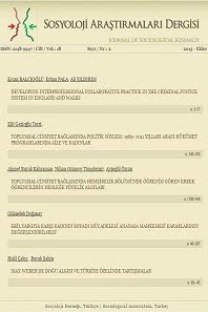CAMİ HUTBELERİNDE BİLİŞE DAİR SÜREÇLER: BAĞLAM, İCRA VE ALGILANMA
Hutbe, Diyanet, Cami hutbeleri, Bilişe dair süreçler
HOW DOES COGNITION WORK IN MOSQUE SERMONS? CONTEXT, DELIVERY, AND PERCEPTION
Friday Prayers, Mosque sermons, Cognition,
___
- Adams, J. ve Padamsee, T. (2001). Signs and Regimes: Rereading Feminist Work on Welfare States. Social Politics, 8(1), 1-23.
- Beaumont, J. (2008). Introduction: Faith-based Organisations and Urban Social Issues. Urban Studies, 45, 2011-2017.
- Becker, G. S. (1976). The Economic Approach to Human Behavior. Chicago: Chicago University Press.
- Béland, D. (2009). Gender, Ideational Analysis and Social Policy. Social Politics, 16(4), 558-581.
- Boyer, P. (2005). A Reductionist Model of Distinct Modes of Religious Transmission. Harvey Whitehouse and Robert N McCauley (Ed.), In Mind and Religion Psychological and Cognitive Foundations of Religiosity (p.3-30). Walnut Creek: Alta Mira Press.
- Brehm, S. S., Kassin, S. ve Fein, S. (2005). Social Psychology. Boston: Houghton Mifflin Company (6th ed.).
- Bourdieu, P. (1991). Language and Symbolic Power. Cambridge: Polity Press.
- Cox, R. H. ve Béland, D. (2013). Valence, Policy Ideas, and the Rise of Sustainability Governance. (forthcoming).
- Campbell, J. (2004). Institutional Change and Globalization. Princeton: Princeton University Press.
- Elder-Vass, D. (2010). The Causal Power of Social Structures. Emergence, Structure and Agency. Cambridge: Cambridge University Press.
- Erdem, G. (2008). Religious Services in Turkey: From the Office of Şeyhülislam to the Diyanet. The Muslim World, 98, 199–215.
- Fairclough, N. (1992). Discourse and Social Change. Cambridge: Polity Press.
- Gaffney, P. (1994). The Prophet Pulpit: Islamic Preaching in Contemporary Egypt. Berkeley, Los Angeles, London: University of California Press.
- Green, N. ve Searle-Chatterjee, M. (2008). Religion, Power, and Language: An Introductory Essay. Nile Green and Mary Searle-Chatterjee (Ed.), In Religion, Power and Language (s. 1-26). New York and London: Routledge.
- Goldstein, J. ve Keohane, R. O. (1993). Ideas and Foreign Policy. Beliefs, Institutions and Political Change. New York: Cornell University Press.
- Hackworth, J. (2012). Faith Based Religious Neoliberalism and the Politics of Welfare in the United States. Athens, Georgia: University of Georgia Press.
- Haney, L. A. (2010). Offending Women. Power, Punishment, and the Regulation of Desire. Berkeley, Los Angeles, and London: University of California Press.
- Haynes, J. (1998). Religion in Global Politics. London and New York: Longman.
- Heather, N. (2000). Religious Language and Critical Discourse Analysis. Oxford et. al.: Peter Lang.
- Hooker, M. B. (2008). Indonesian Syariah: Defining a National School of Islamic Law. Institute of Southeast Asian Studies.
- Iannaccone, L.R. (1995). Voodoo Economics? Reviewing the Rational Choice Approach to Religion. Journal for the Scientific Study of Religion, 34(1), 76-89.
- Iannaccone, L.R. (1990). Religious Practice: A Human Capital Approach. Journal for the Scientific Study of Religion, 29 (3), 297-314.
- Jeeves, M. ve Brown, W. S. (2009). Neuroscience Psychology and Religion. Illusions, Delusions, and Realities about Human Nature. West Conshohocken, PA: Templeton Press.
- Korkut, U. ve Eslen-Ziya, H. (2011). The Impact of Social Conservatism on Population Politics in Poland and Turkey. Social Politics, 18 (3), 387-418.
- Kress, G. (1996). Representational Resources and the Production of Subjectivity. Questions for the Theoretical Development of Critical Discourse Analysis in a Multicultural Society. C.R. Caldas- Coulthard and M. Coulthard (Ed.). In Texts and Practices: Readings in Critical Discourse Analysis (p.15-31). London: Routledge.
- Lindbeck, G. (1984). The Nature of Doctrine: Religion and Theology in a Postliberal Age. London: SPCK.
- McQuillan, K. (2004). When Does Religion Influence Fertility? Population and Development Review, 30(1) s.25-56.
- Percy, M. (1998). Power and the Church: Ecclesiology in an Age of Transition. London: Cassell.
- Pyssianinen, I. (2009). Current Approaches in the Cognitive Science of Religion. Continuum.
- Ram, H. (1994). Myth and Mobilization in Revolutionary Iran: The Use of the Friday Congregational Sermon. Amer University Press.
- Searle, J. R. (2011). Making the Social World the Structure of Human Civilization. Oxford: Oxford University Press.
- Slyke, J. A. V. (2011). The Cognitive Science of Religion. Aldershot: Ashgate.
- Van Dijk, T. (1998). Principles of Critical Discourse Analysis. Jenny Cheshire and Peter Trudgill (ed.), In The Sociolinguistics Reader, Vol. 2, 367-393. London: Arnold.
- Witten, M. G. (1993). All is Forgiven. The Secular Message in American Protestantism. Princeton, New Jersey: Princeton University Press.
- ISSN: 2148-9947
- Yayın Aralığı: 2
- Başlangıç: 2010
- Yayıncı: Sosyoloji Derneği
“BANA MI BAKMIŞTINIZ?”: INTERNETTE YENI BAKIŞ BIÇIMLERI
KADIN YOĞUN MESLEKLERİ ERİLLEŞTİRMEYE YÖNELİK STRATEJİLER: TÜRKİYE’DE ERKEK HEMŞİRELER ÖRNEĞİ
KÜRESEL ŞİRKETLERİN JEOPOLİTİK ETKİSİ
SURİYE KÜRTLERİ: TÜRKİYE KÜRTLERİ'NİN DEVAMI
KİTAP TANITIMI - DAĞ ÇİÇEKLERİM (ANILAR)
SURİYE KÜRTLERİ: TÜRKİYE KÜRTLERİ’NİN DEVAMI
KÜÇÜK İŞLETME SAHİBİ GÖÇMENLER: COLCHESTER’DA YAŞAYAN TÜRK GÖÇMEN GRUBU ÖRNEĞİ
"ARE YOU LOOKING FOR ME?" NEW FORMS OF GAZING ON THE INTERNET
